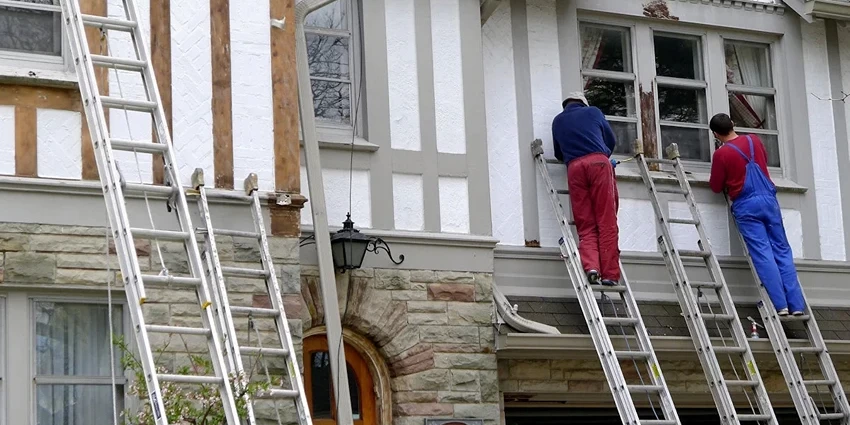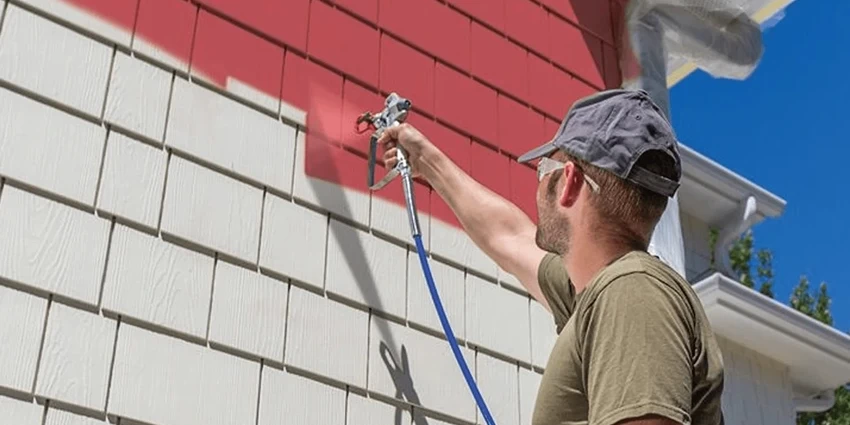All products were chosen independently by our editorial team. This review contains affiliate links and we may receive a commission for purchases made. Please read our affiliates FAQ page to find out more.
Home » Outdoor Paint » Ladder Safety for Painting: A Guide
When it comes to painting, whether it’s a fresh coat for your living room or an exterior makeover for your home, ladder safety should never be an afterthought. In the UK, where DIY projects are a popular weekend activity, understanding how to safely use a ladder is crucial. This guide aims to provide you with essential tips and techniques for ladder safety, ensuring that your painting project is not only successful but also safe.
Key Takeaways
- Choosing the Right Ladder: Select a ladder that suits the job, considering the height and weight capacity needed.
- Proper Ladder Setup: Always ensure the ladder is on solid, even ground and fully locked in place.
- Safe Ladder Practices: Maintain three points of contact and avoid overreaching to prevent falls.
- Ladder Maintenance: Regularly inspect your ladder for any signs of wear or damage.
Understanding Ladder Safety for Painting
Ladder safety is paramount, especially when undertaking painting projects that require you to work at height. The risks associated with ladder use can be significant, from minor injuries to more severe falls. The key to minimizing these risks lies in choosing the right ladder, setting it up correctly, and following best practices for safe use.

Choosing the Right Ladder
Types of Ladders
In the UK, ladders are categorized by their duty rating and material, which indicate their durability and weight capacity. Here’s a quick overview:
- Grade 3 Ladders: Ideal for light domestic use, with a maximum load of 125 kg.
- Grade 2 Ladders: Suitable for regular domestic use, supporting up to 150 kg.
- Grade 1 Ladders: Designed for heavy-duty industrial use, with a capacity of up to 175 kg.
- Grade 1A Ladders: The strongest, supporting a weight of up to 200 kg, perfect for professional painting projects.
Material Considerations:
- Aluminum Ladders: Lightweight and corrosion-resistant, ideal for most painting jobs.
- Fiberglass Ladders: Non-conductive, making them safer for electrical work, with robust durability.
Weight Capacity and Material
Choosing a ladder with the appropriate weight capacity is crucial. It should comfortably support your weight plus any tools or paint you’re carrying. Material-wise, aluminum ladders are popular for their lightness and ease of maneuverability, while fiberglass ladders offer added safety for electrical work, thanks to their non-conductive properties.
Proper Ladder Setup

Ensuring Even, Solid Ground
Before setting up your ladder, check that the ground is even and solid. Avoid wet grass or loose gravel, which can cause the ladder to slip. Always use a ladder on a firm, level surface to prevent accidents.
Utilizing Spreaders or Safety Bars
Most ladders come equipped with spreaders or safety bars that lock the ladder into place, providing stability. Ensure these are fully engaged before climbing.
Ladder Stabilizers and Accessories
For projects requiring roof access or reaching high ceilings, ladder stabilizers can be a game-changer. These accessories provide extra stability, reducing the risk of the ladder tipping over.
| Accessory | Use |
| Ladder Stabilizer | Adds stability, especially when accessing roofs or uneven surfaces. |
| Brush Extension | Allows you to reach higher without overstretching, ideal for tall ceilings. |
Safe Ladder Practices for Painters
Climbing and Working Safely
When climbing a ladder, always face the ladder and maintain three points of contact (two hands and one foot or two feet and one hand). This ensures stability and reduces the risk of falls.
Avoiding Overreaching and Overloading
One common mistake is overreaching while on a ladder, which can lead to loss of balance and falls. Keep your waist within the ladder’s side rails and move the ladder as needed to stay within a safe reach. Also, be mindful of the ladder’s weight limit, including your weight and any tools or materials you’re carrying.
Ladder Maintenance and Inspection
Regular inspection and maintenance of your ladder can prevent accidents. Check for loose screws, damaged steps, or cracks in the material. Any ladder showing signs of wear or damage should be repaired or replaced.

Using Ladders in Unique Situations
Painting in unique or challenging environments, such as stairwells or uneven surfaces, requires additional precautions and the right equipment.
Painting Stairwells with Extension Ladders
When painting stairwells, an extension ladder is often necessary. Opt for a ladder that can be adjusted to different lengths to accommodate the varying heights of the stairwell. A multi-position ladder is particularly useful in these scenarios, offering the flexibility to work safely over stairs.
Handling Uneven Surfaces and Heights
For uneven surfaces, ladder levelers can be invaluable. These attachments allow you to adjust the length of the ladder’s legs, ensuring it remains stable and secure, even on sloped or uneven ground.
| Situation | Recommended Equipment |
| Stairwells | Multi-position ladder, ladder leveler |
| Uneven Surfaces | Ladder leveler, stabilizer |
Ladder Maintenance and Inspection
Regular maintenance and inspection are crucial to ensure your ladder remains safe to use over time. Look for signs of wear, such as cracks, bends, or loose components, and ensure all moving parts operate smoothly.
| Checklist Item | Action |
| Steps and Rungs | Ensure they are secure and free from damage. |
| Locking Mechanisms | Test to ensure they engage fully. |
| Feet | Check for wear and ensure they provide adequate grip. |
Register for our latest in-depth reviews and product round-ups from the experts.
Enter your email address below to receive our monthly review emails.
By entering your details, you are agreeing to our terms and conditions and privacy policy. You can unsubscribe at any time.
FAQs on Ladder Safety for Painting
Select a multi-position ladder with adjustable lengths to safely reach all areas of the stairwell. Ensure it has a suitable duty rating to support your weight plus any tools and materials.
Use a ladder with adjustable legs or a ladder leveler to ensure stability. Always test the ladder for stability before climbing.
- Use a brush extension or roller with an extended handle to reach higher areas without overstretching.
- Reposition the ladder frequently to keep your work within a safe reach.
By adhering to these advanced techniques and addressing common concerns, you can tackle any painting project with confidence, knowing you’re prioritizing safety alongside achieving a professional finish.
Eleanor is the quintessential spirit of the British gardener — passionate, dedicated, and endlessly curious about the natural world. Born and raised amidst the verdant landscapes of the Cotswolds, she developed an early love for the outdoors, often spending hours in the family garden with her hands buried in the soil, nurturing every type of plant she could find.








